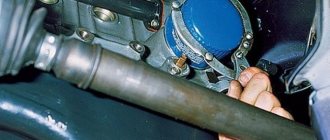Changing the oil in a manual transmission: when and why the lubricant needs to be changed
Let's start with the fact that the “mechanics” is a reliable unit.
First of all, the relative simplicity and time-tested design allows you to operate a car with this type of gearbox for at least 150-200 thousand kilometers without repairing the gearbox. However, you need to understand that this is only possible if the unit is serviced in a timely manner and does not experience serious loads. In other words, the driver is experienced and knows how to drive a manual car correctly. Also, a responsible owner constantly monitors the condition of the transmission oil, eliminates minor faults in a timely manner (leaks of oil seals, gaskets and gearbox seals, replacing the clutch at the slightest sign of wear, adjusting the rocker, etc.).
As for maintenance, for a manual transmission this procedure involves changing the transmission oil. Since the oil in a manual transmission is not a working fluid, the main purpose of replacing it is to reduce wear of parts to increase the overall service life of the unit.
Also, in parallel with replacing the lubricant, the manual transmission pan is cleaned of dirt and deposits, and the magnets on which metal shavings accumulate as a result of natural wear and tear of the gearbox parts are cleaned.
At the same time, experts recommend replacing every 50-60 thousand km or once every 4-5 years (whichever comes first). If the car is used in difficult conditions (constant transportation of goods, towing a trailer, jerky driving with changes to lower and higher gears at high revs and speeds, driving in mountainous areas, etc.), then the replacement interval should be reduced by a third.
Certain signs may also indicate the need to change the lubricant in the mechanic's gearbox. For example:
- during operation of the gearbox, extraneous noise and/or vibration appears in the gearbox;
- gears may be difficult to engage until the box warms up in winter;
- It is difficult to shift gears into hot gears; gears are engaged with a crunch;
First of all, in such a situation, you need to pay special attention to the amount of lubricant in the gearbox, that is, check the oil level in the manual transmission. At the same time, the quality of the lubricant should be assessed. If everything is in order with the level, this does not mean that the unit does not need to be serviced
Although the gear oil in a manual transmission does not heat up as much as in automatic transmissions or CVTs, the lubricant is still subject to oxidation, aging and loss of a number of useful properties. As a result, the viscosity characteristics change, the additives in the oil are used and may precipitate.
If everything is in order with the level, this does not mean that the unit does not need to be serviced. Although the gear oil in a manual transmission does not heat up as much as in automatic transmissions or CVTs, the lubricant is still subject to oxidation, aging and loss of a number of useful properties. As a result, the viscosity characteristics change, the additives in the oil are used and may precipitate.
In the process of lubricating gears, shafts and other gearbox parts, transmission fluid also actively accumulates wear products (metal shavings). Regular heating and cooling can also lead to the accumulation of condensation in the oil, etc.
It is not difficult to guess that if, without other visible reasons, the quality of the gearbox has deteriorated and the above symptoms appear, this indicates that the functionality of the oil in the gearbox has decreased significantly, while the overall wear of the unit has increased significantly.
Let us also add that much will depend not only on the level and “freshness” of the lubricant, but also on how correctly the oil in the gearbox is selected. In other words, the use of transmission oil that is not suitable for tolerances and properties can quickly destroy a fully functional unit.
Volkswagen Golf Variant TDI VAG'on › Logbook › Maintenance #4. Changing the oil in manual transmission
How long does it take to change the gearbox oil?
Many have heard and read fairy tales about how “the oil in the box is filled for its entire service life.” And next to you you will definitely find a person who will prove this with foam at the mouth. There is one more point. They don’t write anywhere about a complete oil change; everywhere they mention checking the oil level and topping it up. But mixing old oil with new oil, in my opinion, is not changing the oil in the engine, but simply topping it up. In my 5 manual transmission with the abbreviation LUB, when changing the oil indiscriminately, 1.8 liters are required according to ELSA (selection of oil through the manufacturer’s catalog gives 1.9 liters). A difference of 100g will not bring any negative effects, since strong oil pressure is not created in the manual transmission.
A post on the Oil club helped in the final choice of oil. Many people expressed the opinion that it is Fuchs Titan Sintofluid FE SAE 75W API GL-4 that is used for conveyor filling. There is no doubt about the originality of the oil, since it is purchased through Auto1. And my engine is filled with Fuchs oil, which I have no complaints about. Read about choosing oil HERE.
So, what does ELSA tell us:
1. Checking the oil level in the gearbox through the filler hole is impossible. Due to the tilt of the power unit, the lower edge of the filler hole (arrow 1) is below the oil surface (arrow 2). Therefore, you can only check the oil level in the gearbox by completely draining it (then you need to refill the oil). A very interesting feature, and if you change the oil without instructions, you will immediately end up with the wrong level.
2. Lock the gear selector rod as follows:
— Press the gear selector rod (arrow 1). — At the same time, turn the lock -A- upwards in the direction of -arrow 2- and insert it into the gear selector rod with light pressure.
3. Drain the oil by unscrewing the oil drain plug (arrow 1) and removing the axle (arrow 2). Install the axle (arrow 2) with a new sealing ring.
4. Screw the plug into the oil drain hole (arrow 1). Turn lock -A- in direction of arrow to original position, thereby unlocking gear selector rod.
5. Add transmission oil to the container containing the oil drained from the gearbox, up to 1.8 liters. Remove the reversing light switch -F4- -arrow-. Connect a hose (approximately 600 mm long, with an outer diameter of 10 mm) to the funnel. The other end of the hose must be inserted into the mounting hole of the reversing light switch.
As you can see, changing the oil in such a box has its own peculiarities.
In addition to oil, you need: 1. TORX 20 and TORX 30 for removing engine and gearbox protection. I advise you to unscrew the screws that are closest to the radiators first. 2. Hexagon 17 for unscrewing the drain plug. 3. Socket wrench 22 for unscrewing the reverse sensor. It would be ideal if it were like a ratchet, since there is very little space and the key travel is small. 4. Hose with an outer diameter of 10mm 5. Watering can. 6. Containers up to 3 liters.
Only after unscrewing the drain plug did it become clear that the oil had already been changed and... it was poured through the “filler” hole, through which it cannot be poured. As a result, only 1.1 liters of oil was drained, which is exactly how much is poured through the wrong filler hole. When exposed to light, the oil was yellowish, as it should be, but now in the bucket it was black.
I filled in 1.8 liters of oil, and this procedure can be carried out alone, since the hose goes about 2 cm into the place where the reverse sensor fits, and additional control over it is not needed.
It feels like after changing the oil, the gears engage easier, especially the rear one. Due to the transverse position of the engine, the gears are, in principle, engaged with force, so changing the oil and setting its level definitely has an effect. The replacement process is simple and, as my case showed, it won’t be unnecessary.
When is it time to change the oil?
Instructions for changing gearbox oil on Lada Priora
On average, an oil change in a car needs to be done after 30-40 thousand kilometers of driving. However, this is a general case and the transmission oil needs to be examined every 10 thousand kilometers (during a technical inspection), because special circumstances may arise or problems may arise that you are not even aware of (for example, an oil leak).
The vehicle's technical manual describes in detail all the indicators at which the oil should be replaced with new one. This can be either the mileage traveled or the desired period of time.
Typically, manufacturers advise replacing them once every 60-90 thousand kilometers or once every three years, but in special operating conditions it is advisable to do this twice as often.
There are some cases in which an oil change is mandatory, even if the specified period has not passed and the car has not driven a long distance:
- If during one of the checks it was noticed that there is too little liquid in the box.
- Silver dust was found in the transmission fluid.
- If the liquid for some unknown reason has changed color (for example, it has become browner or completely black). This may be caused by deteriorating elements or water entering the liquid.
What if you take engine oil?
Only special motor oil is used for the transmission. Although there are some foreign manufacturers who advise using regular motor oil instead (Honda, Peugeot, Chrysler).
If we think logically, this is a dubious idea, because motor oil has a lower density and is unlikely to protect transmission parts as well as a denser substance specifically designed for this purpose.
So, you can find out how much oil is poured into the gearbox both in the technical documents for the car and at the service point, although there are also average values for this indicator.
It is also important to select the correct oil for each road condition and weather and change it on time. If you follow these simple rules, the transmission will last much longer.
Transmission fluid selection
Practice shows that factory transmission oil is of low quality, so immediately after purchasing a car, a whine is noticed in the operation of the gearbox. To extend the service life of the gearbox and also reduce its noise, it is recommended to replace the gear oil with a higher quality one.
Which manufacturer is better to choose?
Advice: You should not fill your VAZ 2112 with expensive oil, which is synthetic. This is a new oil that is used in modern foreign cars with complex mechanisms. The best option would be semi-synthetic
Opinions about transmission manufacturers differ greatly; some support domestic manufacturers, while others, on the contrary, rely on the recommendations of well-known car factories. Which gear oil is better, and which one you choose, depends only on your personal point of view and the ability to evaluate and listen to the advice of experts.
- Liqui Moly;
- Castrol;
- Mobil.
The AvtoVAZ fan club supports both a selection of reputable brands and Russian manufacturers, for example, Rosneftekhim, Lukoil, Rosneft. In any case, the choice of high-quality gear oil for the VAZ-2112 gearbox occurs through a long selection process, where each car owner goes through a long journey of testing and experimentation.
About types of transmission oils
The main task of transmission fluid is to create a thin but durable oil film on the surface of parts and mechanisms, thus protecting them from rapid wear.
Modern industry offers a wide range of different fluids, and the quality of the gearbox depends on the correct choice. At the moment, there are three types of oils: synthetic, semi-synthetic and mineral. Each of these mixtures has its own set of characteristics and properties.
Mineral transmission is the most budget option. This oil has good lubricating properties, but has a significant drawback. In extreme cold conditions it freezes very quickly. This, in turn, creates difficulties when starting the engine in sub-zero temperatures.
Unlike mineral water, synthetics and semi-synthetics have a higher price. In addition, such oils thicken less at low temperatures and are excellent for use in fairly severe frosts. Synthetic and semi-synthetic oils also differ from each other. The consistency of semi-synthetic liquid is thicker than synthetics. It is great for cars with high mileage. Synthetic oil is better used for new gearboxes, as it is thinner and can leak if there are even the smallest defects in the seals.
When choosing products, first of all, you need to pay attention to viscosity. This is exactly what the SAE index indicates.
According to SAE standards, transmission fluids are divided into the following categories:
- Summer oil (marking consists of numbers only).
- Winter mixture (in its designation it has the English letter W - winter).
- All-season liquid. The marking of such a lubricant consists of two numbers, which are separated by the letter W. This oil can be used all year round.
Synthetic and semi-synthetic oils that have the following viscosity classes are suitable for the gearbox:
- SAE80W85 is an all-season liquid with a temperature range from -35 °C to +35 °C.
- SAE75W90 is a mixture used at any time of the year with a recommended temperature range from -40 °C to +35 °C.
- SAE75W85 is a multi-season oil, designed for work within the range of -40 °C...+45 °C.
In addition, when choosing transmission fluid, you can come across the API classification. It implies the systematization of lubricants according to their quality, application and performance characteristics. There are 7 groups in total, but only two are the most popular.
So, for the VAZ 2107 gearbox, the manufacturer recommends the following groups of transmission fluids:
- GL-4. This oil is characterized by the presence of a large number of additives. It is used for gearboxes that operate in high gears at low torques and in low gears at high torques.
- GL-5. This fluid was developed for hypoid gears with high axle displacement. This liquid has proven itself when working in harsh conditions. It is recommended for gears that operate at high speeds with low torques and shock loads on gear teeth.
Brand and volume of oil for the VAZ 2107 gearbox The VAZ 2107 gearbox has two modifications - five-speed and four-speed. And depending on this, the volume of liquid poured varies:
- Four-speed gearboxes require 1.35 liters.
- For five-speed gearboxes, 1.6 liters are required.
What mixture should be poured does not depend on the number of stages. It must be a special transmission, selected in accordance with the recommendations of the automaker. That is, the liquid must correspond to the operating conditions of the vehicle.
Some brands of lubricants that can be poured into the VAZ 2107 gearbox:
- Lukoil TM-5 85W90
- TNK Hypoid 80W90
- Spector 80W90
- Shell Spirax S5 75W90 GL4/5
- Novoil Super T 80W90
- Spectrol Forward 80W90
- Agip Rotra MP 80W90/80W95
- Norsi Trans 80W90/85W90
- MP Gear Lube-LS 80W90/80W140 (GL-5)
Of course, these are not all transmission fluids that can be used for the “Seven” gearbox. But these are the most popular among VAZ 2107 owners.
What kind of oil should I fill in?
Original
The manual transmission of the VAZ-2112 requires ZIC G-FF 75W-85 mineral oil with SAE 75W-85 API GL-4 specifications. Mostly in winter you can use oil with a viscosity of SAE 70W, 75W, 80W or 85W, and in summer SAE 90, 140 or 250 is recommended. For year-round use, it is better to choose an all-season oil with a viscosity of SAE 75W-80, 80W-85, 85W-90, 75W- 90 or 80W-90.
Unoriginal
Owners of VAZ-2112 cars with a manual transmission can use any gear oil with the characteristics 75W-85. For cars of recent years of production, you can choose semi-synthetic oil, and for older models - mineral oil. It has a thicker consistency, which means there is less chance of leaks in the presence of microcracks or gaps between contact pairs. Among other parameters, it is important to pay attention to oil with API-GL-4 approval, which provides a sufficient amount of useful additives for a manual transmission. For example, suitable oils include Valvoline Durablend 75W-90, Lada Trans KP 80W85, Lukoil TM-412 80W-85, BP Energear HT 75W-90.
The process of changing the oil in a VAZ 2107 gearbox
Before changing the oil in the VAZ 2107 gearbox, let's decide on the necessary tools and consumables. Here they are:
- open-end wrench 17;
- hexagon 17;
- 2 liters of GL-4 class gear oil;
- oil syringe (sold at any auto store, costs about 600 rubles);
- rags;
- container for draining waste.
Sequence of work
Before starting work, the car will have to be driven either onto an overpass or into a viewing hole. Without this, it will not be possible to drain the transmission oil.
The drain plug on the crankcase is carefully wiped off dirt and dust using a rag. The filler hole located on the right side of the crankcase is also wiped.
A container is placed under the crankcase to drain the waste (it is better if it is a small basin). After this, the drain plug is unscrewed using a hexagon.
The transmission oil begins to drain. Despite the small volume, the grease can take a long time to drain (sometimes it takes 15 minutes, especially if draining occurs in the cold season). After the oil is completely drained, the plug is carefully wiped with a rag and wrapped in place. Using an open-end wrench 17, unscrew the filler plug on the crankcase
It also needs to be cleaned of dirt using a rag (and special attention should be paid to the threads. It is very small on this plug, and if dirt gets into the plug, it is extremely difficult to wrap, so the thread can be easily torn off).
New oil is poured into the open hole using an oil syringe
When the required oil level in the box is reached, the filler plug is screwed back in.
Video: changing the oil in the VAZ 2107 gearbox
There are a couple of important nuances, without mentioning which this article would be incomplete. First of all, oil temperature. If the engine is cold, the oil in the box will be viscous, and draining it will take longer, and it is far from certain that the oil will drain completely. On the other hand, if the engine is hot, then unscrewing the drain plug can seriously burn you: in some cases, the oil can heat up to 80 degrees. Therefore, the best option before starting draining is to let the engine run for 10–15 minutes. But no more.
And you shouldn’t rush to pour new oil into the box. Instead, you should take a closer look at the work done in the pelvis. If metal filings or shavings are clearly visible in the old oil, the situation is bad: the gearbox needs urgent repair. But you will have to wait to add oil. It should be said here that shavings in old oil are not always visible: they usually lie at the bottom, and can only be seen in a shallow basin. If the oil is drained into a bucket, then you won’t be able to see the warning signs. But there is a way out: you need to use a regular magnet on a thread. It is enough to dip it in the oil, move it a little along the bottom of the container, and everything will become clear.
And finally, safety precautions. This is something that many novice car enthusiasts forget about. It should be remembered: even a small drop of hot oil that gets into the eye can lead to very serious consequences. Up to the loss of an eye. Therefore, before unscrewing the drain plug, be sure to wear safety glasses and gloves.
So, every car enthusiast can fill the VAZ 2107 with oil. No special skills are required for this. All you need is the ability to hold a wrench, an oil syringe and remember some of the subtleties outlined in this article.
How much oil is poured into a 16-valve VAZ-2112 engine
Car: VAZ-2112. Asks: Abramov Viktor. The essence of the question: How much oil is needed for a complete replacement in a VAZ-2112 engine?
Hello, help me with this question! I have a 16-valve VAZ-2112, produced in 2004. I bought this car recently, and it is my first! I want to prepare it before winter and change the oil, I want to change it myself, but I just don’t know how much of it should be poured into the system. Please tell me!
About oil change
As a rule, when purchasing a used VAZ-2112, you can find a special manual in the cabin that helps most motorists when making certain repairs.
The following two tabs change content below.
This also applies to all the main parameters of the liquid poured into a particular system unit. However, if there is no such instruction, then our article will be just the thing to help. Read below about how much oil needs to be poured into the VAZ-2112 engine.
Oil volume in VAZ-2112 according to the passport
Since the days of the old VAZ-2108 and their models of carburetor and injection engines, nothing has seriously changed, and, therefore, the volume of oil poured remains the same. Even if you pay attention to the fact that there is a significant difference in the cylinder head, which on a two-wheeler is most often sixteen-valve (one of the modifications of the 21124 engine - approx.), but the cylinder block is still the same, therefore, the pan is completely identical to the tank in 3.5 liters.
It’s easy to change the oil on a VAZ-2112 yourself.
An interesting fact is that the volume of 3.5 liters refers to the total component, counting the 300 ml that is poured into the oil filter.
This will fit another 300 ml
Thus, you can understand that the net volume that is poured directly into the neck is approximately 3.2 liters.
In any case, when you pour oil into the engine with your own hands, its quantity will be controlled using an oil dipstick, where the MIN and MAX marks should serve as your guide.
Oil level is at minimum.
carfrance.ru
How to check the speed sensor for functionality
Symptoms of defects in this device are as follows:
- suspension of engine operation during translational movement in idle mode and incorrect speedometer values being presented at the same time;
- When defects are detected in the electrical circuit of the speed sensor, the price of which is quite reasonable, the light banner “CHECK” is displayed with parallel recording of the error code “24” in RAM.
Important: such a recording is possible even if there are defects in the operation of the mass air flow sensor, but because
The “CHECK” banner in this version is not constantly displayed, then perhaps this difference will indirectly indicate which device has failed in operation.
How does the checkpoint work?
To understand why high-quality oil is the key to good gearbox performance, you need to understand what this unit does and how it works. The engine rotates the crankshaft at a fairly high speed, but with low torque, which is why the transfer of energy directly from the engine to the wheels is possible only at high speeds, where it is enough to maintain a given pace of movement. Therefore, it is necessary to reduce the crankshaft rotation speed while simultaneously increasing the torque. This is exactly what the gearbox does. Regardless of the type of gearbox, the principle of operation is always the same - a gearbox consisting of a large and small gear either reduces the shaft rotation speed, increasing torque, or, conversely, increases the rotation speed, reducing torque. At the same time, the power remains unchanged.
Gear shifting occurs due to a different combination of the drive and driven gears of the gearbox. In a manual (manual) transmission, the driver, using a lever that operates the fork system, connects the desired combination of gears. In an automatic transmission (automatic transmission), this process is controlled by various systems. In CVT gearboxes, there is no control system, and its function is performed by a drive gear or pulley, depending on the design of the unit.
When the gearbox converts rotation speed and torque, its gears come into close contact with each other, causing their teeth to wear out under the influence of friction. The oil almost completely eliminates friction, thereby reducing gear wear. When shifting gears, the forks activate the gears, moving them along the primary and secondary shafts, causing their teeth to mesh. High-quality oil facilitates gear shifting and lubricates and cools gears and bearings. In automatic transmissions, oil cools the electrical and mechanical components of the box, and is also often the working medium of the gear selection system. All this allows us to conclude that the oil should be:
- quality;
- corresponding gearbox for viscosity;
- corresponding gearboxes for maximum and minimum temperatures.
General information about manual transmission
The gearbox in a car is the most important structural driving element of the entire transmission. The vehicle's gearbox is designed to transform the torque from the engine to the chassis, the speed and direction of movement of the vehicle, and also serves to permanently disconnect the engine from the transmission. So:
- A manual gearbox (this type is installed on the VAZ 2112 and many other VAZ models, in everyday life it is simply a mechanic or a manual transmission) is a cylindrical multi-stage gearbox, in which only manual gear shifting is developed
- There are four-speed and five-speed (no longer required for VAZs), there are also six-speed, seven-speed and even more gearboxes
- As you understand, the classification depends on the number of stages (gears), reverse gear is not considered in this classification
- For example, a four-speed gearbox has four forward gears and a reverse gear, and so on.
- The main advantages of a mechanical box are: simplicity and reliability of the design. Possibility of manual control in any mode of movement of the machine
- Thanks to these qualities, manual transmission is still the most common type of transmission.
- However, today, more and more consumers are choosing automatic transmissions
Difference in oil by box type
In addition, oils must be distinguished by their properties. Today, two types of oils are known: for automatic transmissions and for manual transmissions. Here's where they differ.
This is interesting: Is it possible to mix motor oils of different types and brands?
For manual transmission
Manual transmission oils (or MTF) effectively relieve mechanical stress, lubricate friction pairs, and remove heat and rust particles.
For automatic transmission
- The difference between automatic transmission oils (they are labeled as ATF) is that higher requirements apply to them than to lubricants for manual transmissions. This oil acts as a transmitter of mechanical energy in the entire transmission system. It's more of a hydraulic fluid than regular oil;
- These oils are not only able to lubricate gears, but also provide a liquid medium, as well as smooth operation of friction mechanisms, better remove heat and protect against corrosion;
- They have a higher viscosity index and better resistance to foaming;
- ATF lubricant has a weaker effect on oil seals and various elastomers than manual transmission oil;
- Such oils must be very resistant to oxidation.
Table of known automatic transmission oils
| Brand | Description | Purpose |
| Dexron 3 | Automatic transmission oil that meets the latest requirements of leading manufacturers | For cars with Step-tronic, Type-tronic, automatic transmission and so on |
| Euromax ATF | Special fluid for automatic transmissions of foreign cars of a very high quality standard | Boxes Ford Mercon, Chrysler, Mitsubishi Diamond, Nissan, Toyota, etc. |
| Mobile Delvac ATF | Automatic transmission oil that performs exceptionally well at sub-zero temperatures | Trucks with automatic transmission, buses, cars, etc. |
| Toyota ATF | Oil with special additives that protect against corrosion and excessive wear | Boxes of Toyota and Lexus cars |
| Honda ATF | Oil using special ingredients to protect seals and O-rings | Automatic transmissions of all Honda models |











